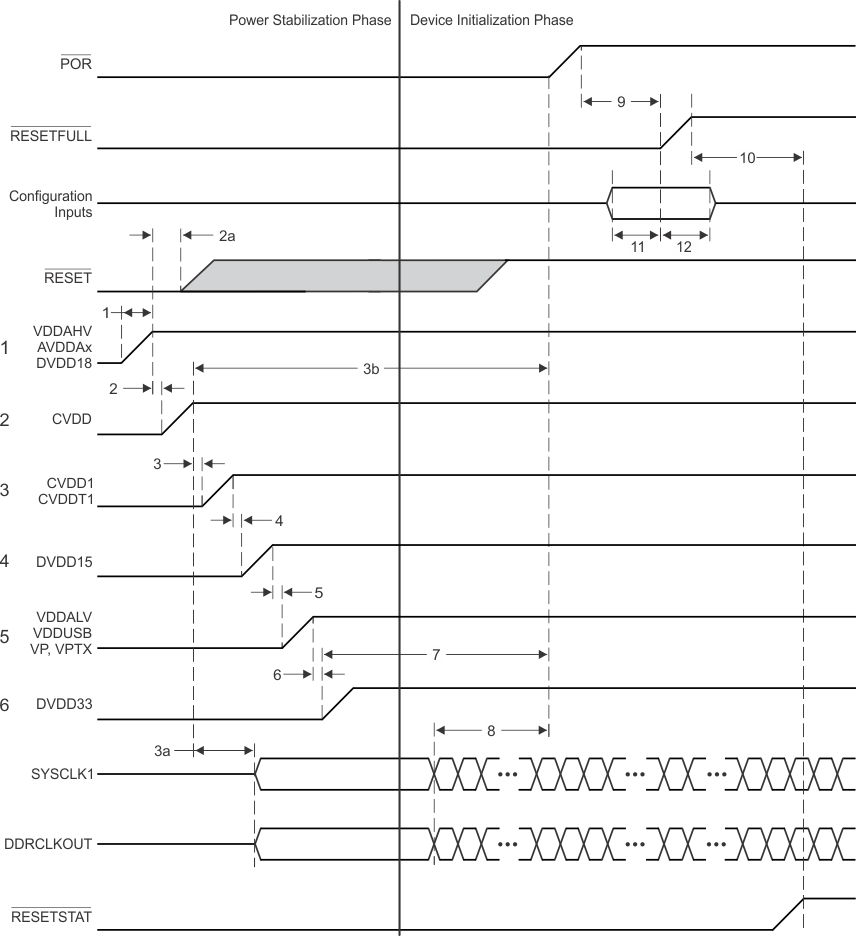ZHCSBT2G November 2012 – October 2017 66AK2H06 , 66AK2H12 , 66AK2H14
PRODUCTION DATA.
- 1 器件概述
- 2 修订历史记录
- 3 Device Comparison
- 4 Terminal Configuration and Functions
- 5 Specifications
- 6 C66x CorePac
- 7 ARM CorePac
-
8 Memory, Interrupts, and EDMA for 66AK2Hxx
- 8.1 Memory Map Summary for 66AK2Hxx
- 8.2 Memory Protection Unit (MPU) for 66AK2Hxx
- 8.3 Interrupts for 66AK2Hxx
- 8.4 Enhanced Direct Memory Access (EDMA3) Controller for 66AK2Hxx
- 9 System Interconnect
-
10Device Boot and Configuration
- 10.1
Device Boot
- 10.1.1 Boot Sequence
- 10.1.2
Boot Modes Supported
- 10.1.2.1 Boot Device Field
- 10.1.2.2 Device Configuration Field
- 10.1.2.3 Serial Rapid I/O Boot Device Configuration
- 10.1.2.4 Ethernet (SGMII) Boot Device Configuration
- 10.1.2.5
Boot Parameter Table
- 10.1.2.5.1 EMIF16 Boot Parameter Table
- 10.1.2.5.2 SRIO Boot Parameter Table
- 10.1.2.5.3 Ethernet Boot Parameter Table
- 10.1.2.5.4 PCIe Boot Parameter Table
- 10.1.2.5.5 I2C Boot Parameter Table
- 10.1.2.5.6 SPI Boot Parameter Table
- 10.1.2.5.7 HyperLink Boot Parameter Table
- 10.1.2.5.8 UART Boot Parameter Table
- 10.1.2.5.9 NAND Boot Parameter Table
- 10.1.2.5.10 DDR3 Configuration Table
- 10.1.2.6 Second-Level Bootloaders
- 10.1.3 SoC Security
- 10.1.4 System PLL Settings
- 10.2
Device Configuration
- 10.2.1 Device Configuration at Device Reset
- 10.2.2 Peripheral Selection After Device Reset
- 10.2.3
Device State Control Registers
- 10.2.3.1 Device Status (DEVSTAT) Register
- 10.2.3.2 Device Configuration Register
- 10.2.3.3 JTAG ID (JTAGID) Register Description
- 10.2.3.4 Kicker Mechanism (KICK0 and KICK1) Register
- 10.2.3.5 DSP Boot Address Register (DSP_BOOT_ADDRn)
- 10.2.3.6 LRESETNMI PIN Status (LRSTNMIPINSTAT) Register
- 10.2.3.7 LRESETNMI PIN Status Clear (LRSTNMIPINSTAT_CLR) Register
- 10.2.3.8 Reset Status (RESET_STAT) Register
- 10.2.3.9 Reset Status Clear (RESET_STAT_CLR) Register
- 10.2.3.10 Boot Complete (BOOTCOMPLETE) Register
- 10.2.3.11 Power State Control (PWRSTATECTL) Register
- 10.2.3.12 NMI Event Generation to C66x CorePac (NMIGRx) Register
- 10.2.3.13 IPC Generation (IPCGRx) Registers
- 10.2.3.14 IPC Acknowledgment (IPCARx) Registers
- 10.2.3.15 IPC Generation Host (IPCGRH) Register
- 10.2.3.16 IPC Acknowledgment Host (IPCARH) Register
- 10.2.3.17 Timer Input Selection Register (TINPSEL)
- 10.2.3.18 Timer Output Selection Register (TOUTPSEL)
- 10.2.3.19 Reset Mux (RSTMUXx) Register
- 10.2.3.20 Device Speed (DEVSPEED) Register
- 10.2.3.21 ARM Endian Configuration Register 0 (ARMENDIAN_CFGr_0), r=0..7
- 10.2.3.22 ARM Endian Configuration Register 1 (ARMENDIAN_CFGr_1), r=0..7
- 10.2.3.23 ARM Endian Configuration Register 2 (ARMENDIAN_CFGr_2), r=0..7
- 10.2.3.24 Chip Miscellaneous Control (CHIP_MISC_CTL0) Register
- 10.2.3.25 Chip Miscellaneous Control (CHIP_MISC_CTL1) Register
- 10.2.3.26 System Endian Status Register (SYSENDSTAT)
- 10.2.3.27 SYNECLK_PINCTL Register
- 10.2.3.28
USB PHY Control (USB_PHY_CTLx) Registers
- Table 10-57 USB_PHY_CTL0 Register Field Descriptions
- Table 10-58 USB_PHY_CTL1 Register Field Descriptions
- Table 10-59 USB_PHY_CTL2 Register Field Descriptions
- Table 10-60 USB_PHY_CTL3 Register Field Descriptions
- Table 10-61 USB_PHY_CTL4 Register Field Descriptions
- Table 10-62 USB_PHY_CTL5 Register Field Descriptions
- 10.1
Device Boot
-
1166AK2Hxx Peripheral Information
- 11.1 Recommended Clock and Control Signal Transition Behavior
- 11.2 Power Supplies
- 11.3 Power Sleep Controller (PSC)
- 11.4 Reset Controller
- 11.5
Main PLL, ARM PLL, DDR3A PLL, DDR3B PLL, PASS PLL and the PLL Controllers
- 11.5.1 Main PLL Controller Device-Specific Information
- 11.5.2
PLL Controller Memory Map
- 11.5.2.1 PLL Secondary Control Register (SECCTL)
- 11.5.2.2 PLL Controller Divider Register (PLLDIV3 and PLLDIV4)
- 11.5.2.3 PLL Controller Clock Align Control Register (ALNCTL)
- 11.5.2.4 PLLDIV Divider Ratio Change Status Register (DCHANGE)
- 11.5.2.5 SYSCLK Status Register (SYSTAT)
- 11.5.2.6 Reset Type Status Register (RSTYPE)
- 11.5.2.7 Reset Control Register (RSTCTRL)
- 11.5.2.8 Reset Configuration Register (RSTCFG)
- 11.5.2.9 Reset Isolation Register (RSISO)
- 11.5.3 Main PLL Control Registers
- 11.5.4 ARM PLL Control Registers
- 11.5.5 Main PLL Controller, ARM, SRIO, HyperLink, PCIe, USB Clock Input Electrical Data and Timing
- 11.6 DDR3A PLL and DDR3B PLL
- 11.7 PASS PLL
- 11.8 External Interrupts
- 11.9 DDR3A and DDR3B Memory Controllers
- 11.10 I2C Peripheral
- 11.11 SPI Peripheral
- 11.12 HyperLink Peripheral
- 11.13 UART Peripheral
- 11.14 PCIe Peripheral
- 11.15 Packet Accelerator
- 11.16 Security Accelerator
- 11.17 Network Coprocessor Gigabit Ethernet (GbE) Switch Subsystem
- 11.18 SGMII and XFI Management Data Input/Output (MDIO)
- 11.19 Ten-Gigabit Ethernet (10GbE) Switch Subsystem
- 11.20 Timers
- 11.21 Serial RapidIO (SRIO) Port
- 11.22 General-Purpose Input/Output (GPIO)
- 11.23 Semaphore2
- 11.24 Universal Serial Bus 3.0 (USB 3.0)
- 11.25 EMIF16 Peripheral
- 11.26 Emulation Features and Capability
- 11.27 Debug Port (EMUx)
- 12Device and Documentation Support
- 13Mechanical, Packaging, and Orderable Information
11.2.1.2 IO-Before-Core Power Sequencing
The timing diagram for IO-before-core power sequencing is shown in Figure 11-2 and defined in Table 11-3.
NOTE
TI recommends a maximum of 100 ms between one power rail being valid, and the next power rail in the sequence starting to ramp.
Table 11-3 IO-Before-Core Power Sequencing
| ITEM | SYSTEM STATE |
|---|---|
| 1 | Begin Power Stabilization Phase
|
| 2 |
|
| 2a |
|
| 3 |
|
| 3a |
|
| 3b |
|
| 4 |
|
| 5 |
|
| 6 |
|
| 7 |
|
| 8 |
|
| 9 |
|
| 10 |
|
| 11 |
|
| 12 |
|
 Figure 11-2 IO-Before-Core Power Sequencing
Figure 11-2 IO-Before-Core Power Sequencing